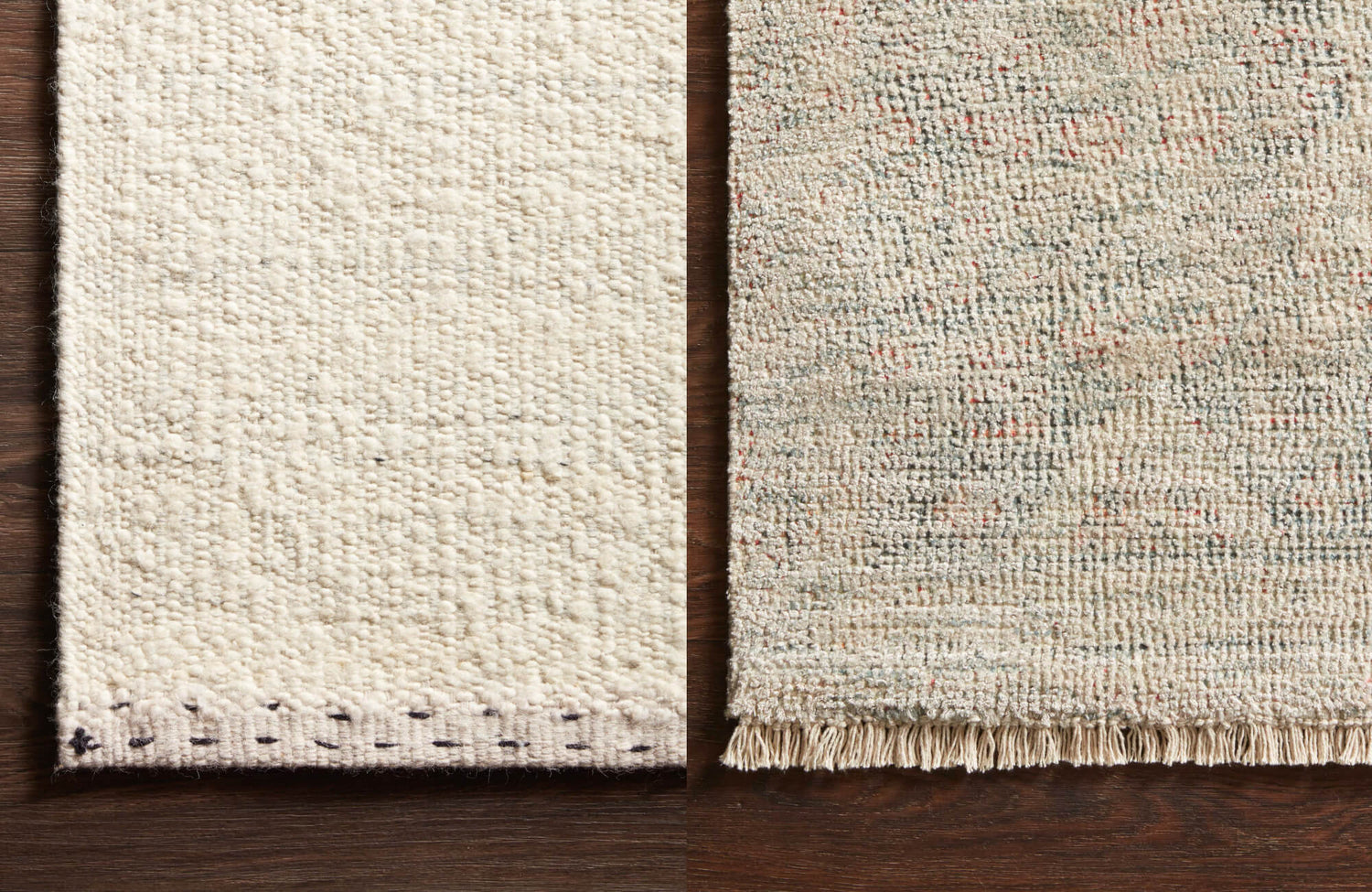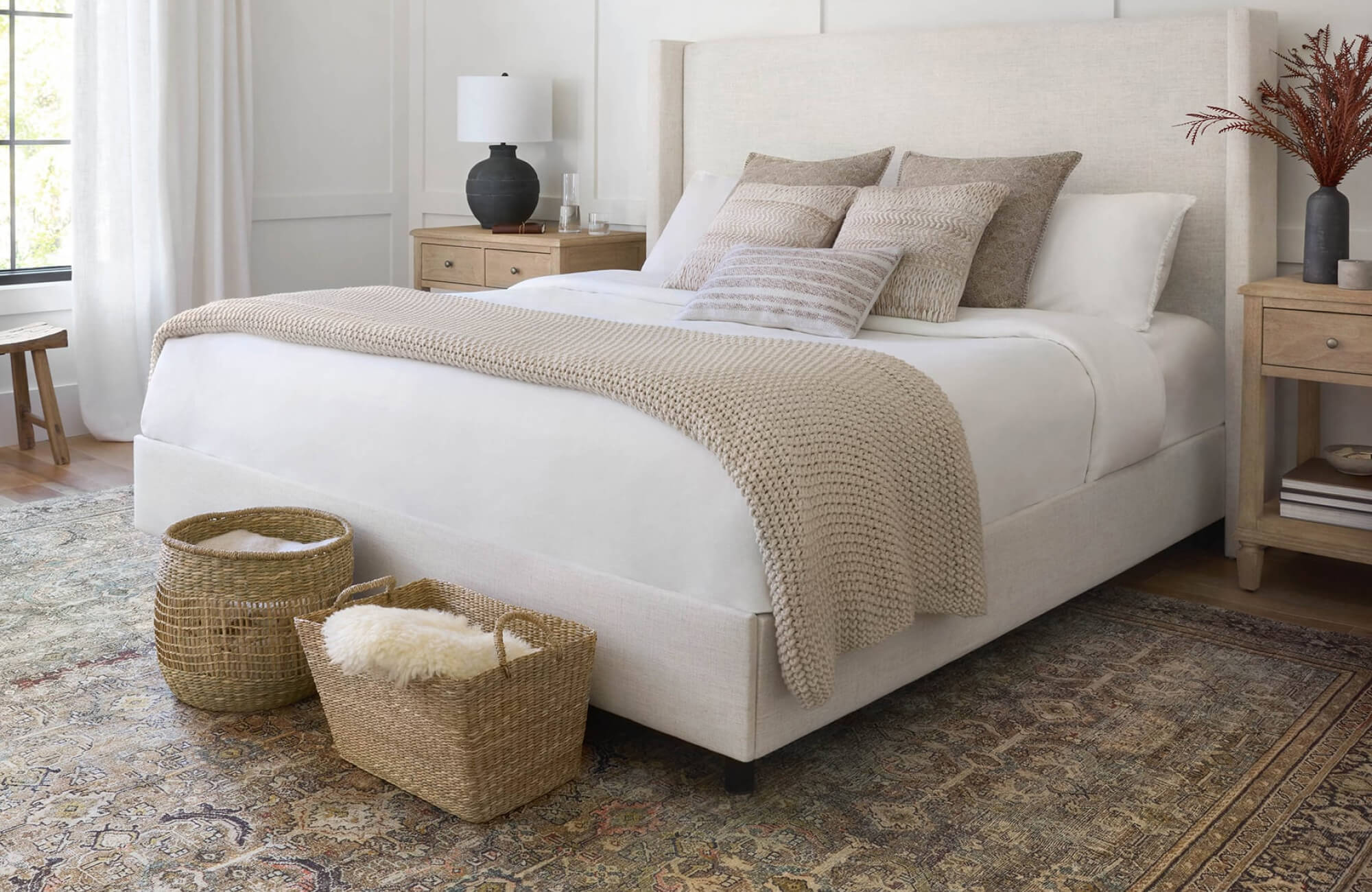Cotton and wool blend rugs combine softness, strength, and versatility, making them a practical and stylish option for various interiors. Wool blends enhance durability and insulation by incorporating fibers like cotton, polyester, or rayon, ensuring a plush yet resilient texture. Meanwhile, cotton blends offer a lightweight structure that maintains airflow while reinforcing durability through synthetic or natural fiber combinations.
In this article, we’ll explore the distinct characteristics of cotton and wool blends, their advantages, and how they compare to other materials. Plus, we’ll discuss key considerations to help you choose the best rug for your space.

Wool Blend Rugs and Their Advantages
Wool is obtained through a careful shearing process, where sheep are trimmed to collect their fleece without harm. Once cleaned and spun into yarn, the fibers retain their natural softness and resilience, making them ideal for textiles. When blended with fibers such as cotton, polyester, or rayon, wool’s inherent strength is enhanced, creating rugs that maintain their plush texture while improving resistance to daily wear.
Apart from durability, wool blend rugs such as our Leticia Wool Blend Rug in Natural, as seen above, introduce greater versatility in texture and design. The added fibers allow for intricate weaving techniques, creating depth and dimension that suit various decor styles. Plus, the blend helps minimize shedding and increases stain resistance, making upkeep more manageable. With their ability to balance sophistication and everyday functionality, these rugs serve as a stylish yet practical solution for a variety of interiors.
Wool blends also contribute to sustainability, as wool is a biodegradable and naturally sourced material. When combined with synthetic fibers, these rugs become even more long-lasting, reducing the need for frequent replacements and minimizing waste. Their durability and eco-conscious qualities make them an excellent choice for those seeking a balance between style, practicality, and environmental responsibility.

Cotton Blend Rugs and Their Benefits
Cotton is harvested from the fluffy bolls of the cotton plant, which are carefully picked and processed to separate the fibers from the seeds. Once cleaned and spun into yarn, the fibers become soft yet durable, making them an excellent foundation for textiles. Cotton blend rugs combine this natural softness with fibers like wool, polyester, or rayon, resulting in a more durable and practical option for everyday use.
While pure cotton rugs can wear down over time, blending them with stronger fibers enhances their longevity without compromising comfort. The lightweight nature of cotton keeps the rug airy and adaptable, making it an excellent choice across various settings. Cotton blends are also a sustainable option, as cotton is a naturally renewable and biodegradable material.
Cotton blend rugs such as our Marcela Cotton Blend Rug in Natural / Opal, as shown above, offer an eco-conscious yet practical choice, featuring a refined texture with a seamless blend of cotton and synthetic fibers, ensuring lasting quality while reducing overall waste. When mixed with synthetic materials, these rugs gain added strength and stain resistance, making them a reliable option for both comfort and longevity.

Weaving Techniques Used in Cotton and Wool Blend Rugs
Weaving plays a crucial role in the durability, texture, and aesthetic appeal of cotton and wool blend rugs. Different techniques create distinct looks and performance levels, making some better suited for cozy living spaces while others are ideal for everyday use. Understanding these weaving styles helps you choose the perfect rug to complement your home’s style and needs.
Handweaving
Handwoven rugs are crafted using time-honored techniques that emphasize skill, artistry, and attention to detail. Each rug is made by interlacing fibers by hand, resulting in one-of-a-kind patterns and textures that machine-made rugs can’t replicate. Because of this meticulous process, handwoven cotton and wool blend rugs often have a rich, organic feel that adds character and warmth to any space.
Apart from their unique appearance, handwoven rugs are also known for their durability. The tight, intricate weaving strengthens the rug’s structure, ensuring it holds up well over time. This makes them an excellent choice for those looking for an investment piece that combines traditional craftsmanship with lasting quality. While they may come at a higher price point, their longevity and timeless appeal make them a worthwhile addition to any home.
Tufting
Tufted rugs offer a luxurious, cushioned feel underfoot, making them a popular choice for creating cozy and inviting spaces. These rugs are made by inserting yarn into a backing fabric, forming soft loops or cut piles that create a plush texture. Tufted cotton and wool blend rugs are particularly favored for their ability to blend warmth and softness, making them an excellent option for bedrooms, lounges, and relaxation areas.
Another advantage of tufted rugs is their accessibility, as they are more affordable than handwoven alternatives while still offering a stylish and comfortable look. They also come in a wide range of colors, patterns, and designs, allowing homeowners to find the perfect rug to match their décor. However, since tufted rugs do not have the same level of intricate weaving as handwoven options, they may require more frequent care to maintain their shape and texture over time.
Flat Weaving
Flatweave rugs are known for their tightly woven construction, which creates a durable yet lightweight surface. Unlike tufted or handwoven rugs, they have no pile, making them less likely to trap dust and easier to clean. Cotton and wool blend flatweaves are particularly valued for their practicality, as they provide a comfortable feel without requiring the same level of maintenance as higher-pile rugs.
The versatility of flatweave rugs also makes them a great addition to various interior styles. They are available in an array of bold patterns, geometric designs, and neutral tones, allowing them to fit effortlessly into both modern and traditional spaces. Their lightweight nature makes them easy to move and reposition, offering flexibility for those who enjoy switching up their décor. Whether used as a layering piece or a statement accent, flatweave rugs bring both style and function to any room.
Practical Benefits
Wool and cotton blend rugs provide a perfect mix of durability and low-maintenance care, making them ideal for everyday use. Their versatility allows them to enhance various spaces while offering lasting comfort and resilience.
Easy Maintenance & Care
Wool blend rugs shed less than pure wool rugs, making them easier to maintain while still retaining their plush texture. Their natural resilience also helps them hold their shape and appearance over time, requiring only regular vacuuming to keep them looking fresh. Cotton blend rugs, on the other hand, are more stain-resistant than 100% cotton options, as blended fibers enhance durability and color retention. This makes them particularly useful for homes with pets and children, where easy upkeep is essential. Both wool and cotton blends provide a comfortable yet practical flooring solution, balancing softness with the durability needed for everyday use.
Where They Work Best
Wool blend rugs are an excellent choice for living rooms and bedrooms, where their plush texture and warmth create an inviting and refined atmosphere. Their durability ensures they hold up well in frequently used spaces while maintaining their elegant appearance, making them a stylish yet practical addition to both formal and cozy interiors. In dining areas, wool blends also provide a luxurious underfoot feel while complementing a sophisticated setting.
Cotton blend rugs, on the other hand, are well-suited for casual spaces such as home offices, sitting areas, and sunrooms, where their lightweight and breathable design enhances comfort without overpowering the decor. Their soft yet resilient construction makes them a great option for nurseries and playrooms as well, offering a cozy surface that is easy to maintain. However, neither wool nor cotton blends are ideal for moisture-prone areas like bathrooms, as natural fibers tend to absorb water and may develop mildew over time.

Cotton & Wool Blends vs. Pure Synthetic Fibers
Wool and cotton blends provide a natural balance of softness, durability, and insulation, making them a practical choice for comfort-focused spaces. Wool blends, for instance, retain the insulating properties of wool while incorporating fibers like cotton, rayon, or polyester to improve resilience and minimize shedding. Similarly, cotton blends enhance the lightweight, airy nature of cotton while reinforcing its structure with wool or synthetic fibers for added strength and stain resistance. These blends offer a well-rounded mix of comfort, style, and longevity, making them ideal for those who want a rug that adapts well to everyday use.
Compared to pure synthetic fibers, natural blends provide a more ventilated and eco-conscious option, delivering a soft, organic feel that synthetic rugs often lack. While synthetic materials such as polyester, including options like our Hutchinson Polyester Face Rug in Burgundy / Denim, as seen above, excel in moisture resistance and affordability, they typically do not match the texture, airflow, or insulating benefits of wool and cotton. However, for areas exposed to high moisture or frequent spills, synthetic options may be preferable, as they require less maintenance and are more resistant to water damage.
Seasonal Comfort & Styling
Wool blend rugs are an excellent choice for colder months, providing insulation and warmth that make interiors feel cozier. Their dense fibers help retain heat, creating a naturally inviting atmosphere, especially when paired with plush textiles like throw blankets and thick curtains. For instance, layering a wool blend rug with other soft furnishings enhances both comfort and style, making a space feel warm and well-curated during winter. These rugs not only add a cozy aesthetic but also contribute to maintaining a comfortable indoor temperature.
Cotton blend rugs, on the other hand, offer breathability, making them a great option for warmer seasons. Their lightweight nature helps keep interiors feeling fresh, preventing a room from becoming overly insulated. For example, swapping out heavier decor elements for breezier textures, such as linen curtains or woven baskets, complements the airy feel of cotton blend rugs. This versatility allows interiors to transition seamlessly between seasons, ensuring a balanced, stylish, and comfortable look throughout the year.
While both wool and cotton blends adjust well to seasonal changes, synthetic rugs often lack this adaptability. Materials like polyester and polypropylene do not provide the same insulating warmth as wool or the refreshing lightness of cotton, making them less suited for year-round comfort. Additionally, synthetic rugs may trap heat or feel overly stiff in cooler months, whereas natural fiber blends create a more balanced and comfortable living environment. For those who prioritize both practicality and seasonal adaptability, wool and cotton blends remain the superior choice.
The Perfect Cotton or Wool Blend Rug for Your Home
Cotton and wool blend rugs offer a perfect combination of softness, durability, and style, making them a practical choice for a variety of spaces. Wool blends provide warmth and resilience, while cotton blends offer a lightweight, breathable feel with added stain resistance. Their ability to balance comfort and functionality makes them a reliable option for those looking to enhance their interiors with both beauty and longevity.
When selecting a cotton or wool blend rug for your space, considering factors like material composition, maintenance, and intended use can help you make the right choice. If you have any questions or need help selecting the right cotton or wool blend rug, contact us! Our team is here to ensure you find a rug that seamlessly blends style, comfort, and durability.








